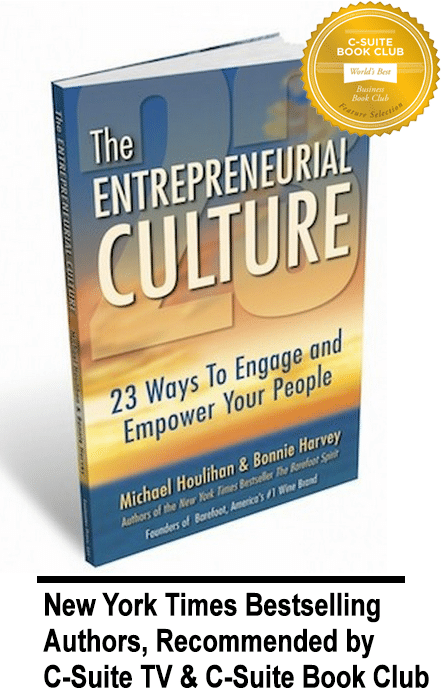For Immediate Release
For an interview with Michael Houlihan,
please contact Dottie DeHart,
DeHart & Company Public Relations,
at (828) 325-4966 or Dottie@dehartandcompany.com.
Michael Houlihan explains that multi-level marketers have a lot in
common with small business owners who must bootstrap their businesses
from the ground up, and offers valuable tactics to help them succeed.
Forestville, CA (February 2013)—Would you be excited if someone told you that you could have the opportunity to control how much money you make? If you’re a multi-level marketer, congratulations: That’s exactly the position you’re in. In many important ways, multi-level marketers are essentially small business owners. And if you want your venture to succeed, says Michael Houlihan, that’s exactly how you need to approach selling your product. Like an entrepreneur who is bootstrapping a business from the ground up, you have a unique opportunity to control your own success—and it all depends on how well you can execute and motivate other people.
“Multi-level marketers bypass conventional distribution channels by going directly to the customer, which is exactly what small business owners on a shoestring budget must do,” says Houlihan, coauthor along with Bonnie Harvey of The Barefoot Spirit: How Hardship, Hustle, and Heart Built a Bestselling Wine “Both types of entrepreneurs must develop a specific set of skills and bootstrap every inch of their initial progress.”
Having built a business from the ground up, Houlihan knows what he’s talking about. He and Harvey are the founders of Barefoot Cellars, the company that transformed the image of American wine from staid and unimaginative to fun, lighthearted, and hip. When they started their company in the laundry room of a rented SonomaCounty farmhouse, they knew almost nothing about winemaking or the wine business. The Barefoot Spirit tells their California-style rags-to-riches story in compelling and colorful fashion, and reveals just what it takes to succeed as an entrepreneur…of any type!
“When Bonnie and I started Barefoot, we found out soon enough that we had to sell our wines directly to the consumer on many levels,” recalls Houlihan. “First, we had to convince retail stores to carry our product. And within those retail stores, we had to market toward our target buyer, who was predominately a female in her mid-thirties who had a few children and who wanted value, consistency, and constant availability. We also relied on selling wine to members of non-profit organizations that we supported, which we called ‘hand-selling.’”
In the process of selling to these different audiences, Houlihan and Harvey learned numerous lessons (often the hard way) that made a crucial difference in sales, and most importantly, customer retention.
“Just as in multi-level marketing, we not only sold to the consumer, we sold to everybody in between, and we did it every day,” Houlihan confirms. “We learned that our success depended on getting our salespeople, distributors, and distributors’ salespeople excited about our product. And in retrospect, I am convinced that if we hadn’t focused on selling Barefoot ‘by hand’ to each customer, so to speak, our brand would never have made it.”
The truth is, Houlihan says, conventional distribution systems are overloaded with products, and many of them—no matter how deserving—get lost in the shuffle. As a multi-level marketer, if you play your cards right, you’re in an ideal position to distinguish yourself and your product in the eyes of customers. Read on for ten of Houlihan’s tips to help you improve your business:
Realize that the customer buys you more than your product. It doesn’t matter how unique, useful, or all-around amazing a product is if the person selling it is disagreeable. Think about it: Chances are, you’ve stopped patronizing a store or restaurant because of rude or unprofessional staff. Why should your customers, or your distributors’ customers, be any different? That’s why, above all else, it’s important for you to honestly assess your customer service skills and determine the type of impression you’re making on potential clients through your attitude, presentation, tone of voice, choice of words, body language, and interactions. (Talk to a trusted mentor or friend if you need an objective opinion.) Then, do the same thing for all of your distributors and make adjustments where needed.
“When people buy a product from an individual, especially on a repetitive basis, the salesperson is who they have the relationship with,” comments Houlihan. “Throughout Barefoot’s history, we were hardly the only wine label with whom retailers could do business. I’m convinced that we were successful only because we placed a priority on developing healthy, friendly relationships with our customers, and on maintaining those relationships through regular conversations and follow-up. Because customers knew and liked Barefoot’s salespeople, they continued to buy and promote our product.”
Know your customer. Knowing your customers will benefit them and you. For each customer, Houlihan recommends answering questions like, When does this person buy? How much does/can he or she buy? Does he or she prefer a certain type of product within our line over others? Then, use the answers to make sure your inventory can handle potential demand, and to offer customers new products and deals in which they might be interested.
“Knowing the answers to these questions can make you and your people indispensible,” Houlihan assures. “Your customers will be able to depend on you and your people to give them the best prices and quantities, and as a result, you’ll enjoy continued success.”
Validate their decisions. When they’re buying a new product, customers want to be able to look you (or your distributors) in the eye and hear what you think about it. Have you tried it? Do you like it? Would you buy it again? How has it made your life better? Most of all, customers want to be able to hear and feel honesty from you when you answer these questions.
“The process of validation helps people make the decision to buy your product, or to buy more of your product,” Houlihan points out. “This is especially true for entrepreneurs who have yet to establish themselves…whether they happen to be fledgling winemakers or multi-level marketers! If you want to go the extra mile in validating a customer’s decision to buy your product, I recommend demonstrating a knowledge of similar products, and without bashing other brands, show how yours is superior. And later, follow up and ask your customers what their experience with your product has been like.”
Give personalized attention. Nobody wants to be just another face in the crowd, or worse yet, a number on an end-of-year report or profit sheet. Instead, customers want to feel that they are special, that they are valued as individuals, and that their needs, wants, and preferences have been taken into account. So, what are you waiting for? Give them those things!
“If you always take into account that everyone wants personalized attention, you’ll be off to a good start,” Houlihan confirms. “Show up and spend some face time—don’t rely on emails or phone calls if you don’t have to. Ask customers about what products they like and why, and find out which ones they don’t like and why. Show an interest in their concerns, and always try to remember something about each person that you can bring up the next time you meet. During my early days as a salesman, I was amazed by how surprised and pleased my clients were when I remembered that one of them was celebrating a special anniversary, or had recently adopted a dog, or was expecting a baby, for example.”
Know your products. If you were a salesperson at a major retailer, you might be able to get away with saying, “I’m not sure how to answer your question—I’m actually not very familiar with the product you’re looking at.” After all, customers understand that hourly employees at a large store aren’t experts on every item on every shelf. But if you’re a multi-level marketer, that answer definitely wouldn’t cut it.
“Since you’re essentially starting and running your own small business, you’ll have to prove your credibility from the ground up,” Houlihan says. “A big part of that is being an expert on all of the products you sell. Trust me; customers know when they are talking to someone who has more positive things to say than they have time to say it, and this knowledge will help them decide to buy your product that much sooner. It gives you credibility, authority, and interest. Make sure all of your distributors and representatives are similarly knowledgeable too, or all of your hard work can be undone.”
Know your configurations. As you know (all too well), it costs money to get your products from “there” to “here.” And according to Houlihan, knowing how to increase your sales and orders to the next largest and most efficient shipping configuration can build your business.
“Shipping cost is a big factor in any business, but it’s especially important to handle it responsibly when you don’t have large financial margins,” he confirms. “When your customer or customers have ordered products that will fill half of the next largest shipper, sell them up to it. When you’re reaching this level, it’s a great time to introduce your customer to new products or cut some deals!”
Sound good on the phone. When you’re bootstrapping a business, you’re going to be on the phone a lot. (And yes, Houlihan does favor phone conversations over email because they’re usually more effective, intuitive, and accurate.) Never forget that your tone of voice, inflection, attitude, and sometimes even posture can be “read” by your customer, and speak accordingly.
“Do whatever you need to do to have a happy, confident attitude before you pick up the phone,” Houlihan advises. “Throughout the conversation, make sure you are sitting up straight or standing. Try putting a mirror in front of your desk (or wherever you make calls) so that you can periodically check your expression—believe it or not, the person on the other end of the line can ‘hear’ you smiling! And if the customer is a major client, go see them in person, or if that isn’t possible, set up a Skype meeting. A customer’s ability to add a face and personality to a name and a voice can increase trust and rapport, and positively influence buying decisions.”
Build a team. As your success in multi-level marketing grows, you’ll begin to recruit distributors and build a team (if you haven’t already). Start with good people, Houlihan urges, and make it your goal to build great people. If you mentor your distributors with general advice as well as granular examples and invest quality time in helping them succeed, you will reap dividends on an ongoing basis.
“At Barefoot, we took hiring new people very seriously,” Houlihan recalls. “I would always observe how a candidate held herself and spoke. If she seemed confident, expressed herself well, and possessed an indefinable quality I call ‘hustle,’ she was halfway to being hired before I ever looked at her résumé. That’s because customer service is the backbone of any business, and people who can best relate to those customers will have the advantage as your team grows.
“Here’s one more piece of advice to take into account as your team grows,” he adds. “Acknowledge individual success to everyone. Each of your distributors will want to imitate that action, and they’ll all be clear on what is—and isn’t—praiseworthy.”
Get organized. If you’re like many people in multi-level marketing, this is your first hands-on experience with entrepreneurship, and it’s likely that you work out of your home. How you approach the organization of your space and your time can contribute significantly to your ultimate success or failure.
“I’ve been there—in Barefoot’s early days, our ‘office’ was the laundry room of a rented farmhouse,” Houlihan shares. “But you know what? That laundry room was Barefoot’s designated place to do business—which is very, very important. Don’t let your work creep out into your living space. Keep regular hours, even though the temptation to work whenever you feel like it is strong. And since you don’t have a company-wide administrative system to help you stay organized, make it a priority to get your paperwork under control with good, rigid systems for files, supplies, and leads. These practices will keep you disciplined and on track.”
Pre-plan your meetings. As might be the case with your workspace, it can be tempting to approach client meetings in a more casual manner than you might in an office environment. Don’t. Once again, Houlihan reminds, your credibility and success derive primarily from the way you present yourself and your product. Unless it really is miraculous, it won’t sell itself.
“Whether you’ll be meeting face-to-face, via video chat, or even talking on the phone, do your homework in advance,” Houlihan suggests. “If there are any gaps in your knowledge, make sure you’ve done the research to fill them. Write out an agenda, and have any necessary paperwork or materials at your fingertips. Be prepared. Think about the outcome you want from the meeting before it starts, and share those goals with the client. Set start and end times, and make an announcement when you are halfway through. Yes, this may sound very regimented, but guess what? That’s why it works. Your customers will appreciate the clarity and consistency they enjoy when interacting with you.”
“Without multi-level marketers, many fantastic products would never have seen the light of day,” Houlihan concludes. “But if you act as though you’re bootstrapping a small business from the ground up—which you essentially are—you’ll increase the chances that the product you’re representing will be in the spotlight on center stage.”
# # #
About the Authors:
Michael Houlihan and Bonnie Harvey, authors of The Barefoot Spirit: How Hardship, Hustle, and Heart Built a Bestselling Wine, started the Barefoot Wine brand in their laundry room in 1986, made it a nationwide bestseller, and successfully sold the brand to E&J Gallo in 2005. Starting with virtually no money and no wine industry experience, they employed innovative ideas to overcome obstacles and create new markets.
They were pioneers in what they termed “worthy cause marketing” and performance-based compensation. They held a comprehensive view of customer service, resulting in the National Hot Brand Award for outstanding sales growth in 2003 and 2004.
They now share their experience and innovative approach to business as consultants, authors, speakers, mentors, and workshop leaders. Their book, The Barefoot Spirit, chronicles the history and lessons learned building the popular Barefoot Wine brand.






